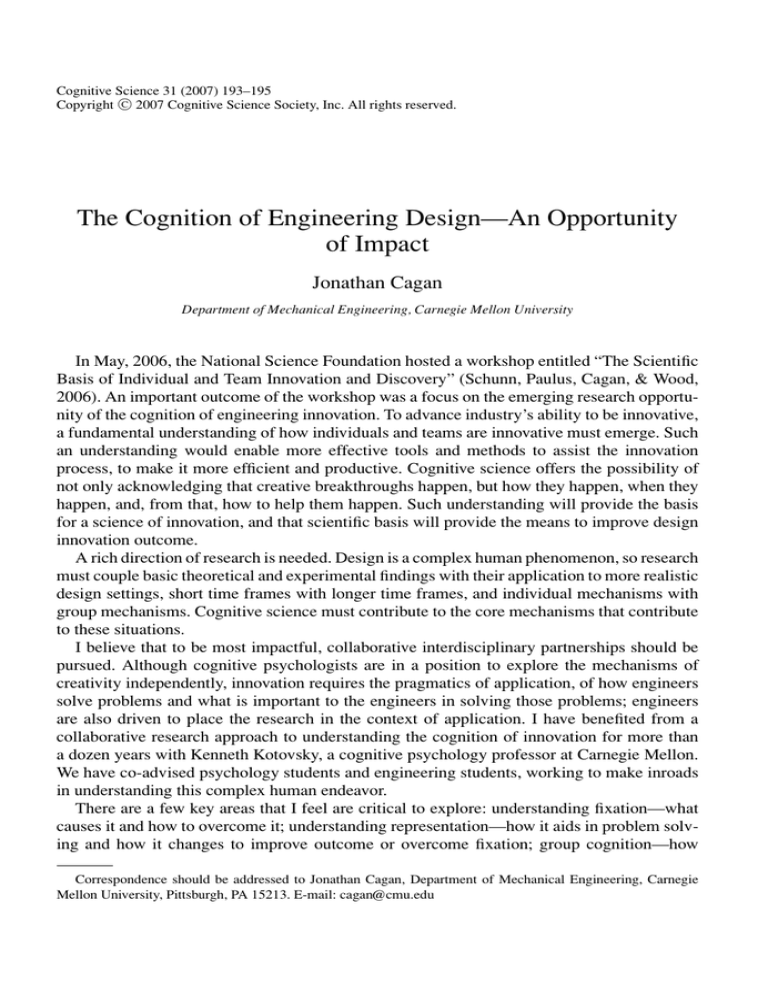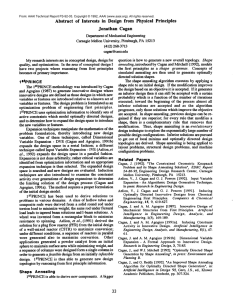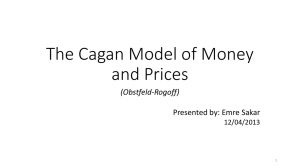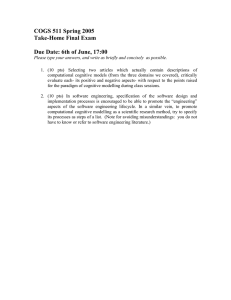
Cognitive Science 31 (2007) 193–195
C 2007 Cognitive Science Society, Inc. All rights reserved.
Copyright The Cognition of Engineering Design—An Opportunity
of Impact
Jonathan Cagan
Department of Mechanical Engineering, Carnegie Mellon University
In May, 2006, the National Science Foundation hosted a workshop entitled “The Scientific
Basis of Individual and Team Innovation and Discovery” (Schunn, Paulus, Cagan, & Wood,
2006). An important outcome of the workshop was a focus on the emerging research opportunity of the cognition of engineering innovation. To advance industry’s ability to be innovative,
a fundamental understanding of how individuals and teams are innovative must emerge. Such
an understanding would enable more effective tools and methods to assist the innovation
process, to make it more efficient and productive. Cognitive science offers the possibility of
not only acknowledging that creative breakthroughs happen, but how they happen, when they
happen, and, from that, how to help them happen. Such understanding will provide the basis
for a science of innovation, and that scientific basis will provide the means to improve design
innovation outcome.
A rich direction of research is needed. Design is a complex human phenomenon, so research
must couple basic theoretical and experimental findings with their application to more realistic
design settings, short time frames with longer time frames, and individual mechanisms with
group mechanisms. Cognitive science must contribute to the core mechanisms that contribute
to these situations.
I believe that to be most impactful, collaborative interdisciplinary partnerships should be
pursued. Although cognitive psychologists are in a position to explore the mechanisms of
creativity independently, innovation requires the pragmatics of application, of how engineers
solve problems and what is important to the engineers in solving those problems; engineers
are also driven to place the research in the context of application. I have benefited from a
collaborative research approach to understanding the cognition of innovation for more than
a dozen years with Kenneth Kotovsky, a cognitive psychology professor at Carnegie Mellon.
We have co-advised psychology students and engineering students, working to make inroads
in understanding this complex human endeavor.
There are a few key areas that I feel are critical to explore: understanding fixation—what
causes it and how to overcome it; understanding representation—how it aids in problem solving and how it changes to improve outcome or overcome fixation; group cognition—how
Correspondence should be addressed to Jonathan Cagan, Department of Mechanical Engineering, Carnegie
Mellon University, Pittsburgh, PA 15213. E-mail: cagan@cmu.edu
194
J. Cagan/Cognitive Science 31 (2007)
the cognitive processes of individuals combine and collaborate for a group level representation and performance; computational studies—how models of cognition can be emulated on
the computer, how those models can improve design tool performance, and whether exploration of those models can give insight into cognitive mechanisms of innovation; analogical
reasoning—how analogies stimulate novel solutions to difficult engineering design problems;
and expertise—how richer representations and knowledge can accelerate design performance.
To highlight a few:
r Mechanical engineering students gain a deeper representation of mechanical search spaces
r
r
r
r
through their education. Seniors are better able to reason about functional transformations
and energy flow than freshmen, leading to a deeper understanding of how mechanical
systems work (Moss, Kotovsky, & Cagan, 2006).
One interesting characteristic of fixation in problem solving is demonstrated by the effect
of open goals on the acquisition of problem relevant information; hints presented implicitly
aid problem solving, particularly in the presence of open goals, but in some situations the
hints are most effective prior to reaching an impasse (Moss, 2006).
Computational simulations of human performance can emulate exploration versus final path
phases of search. A simulated annealing algorithm that dynamically updated its objective
function imitated findings from cognitive studies of people solving puzzle problems such
as the Chinese Rings Puzzle and Tower of Hanoi (Cagan & Kotovsky, 1997).
Cognitively motivated computational models of design processes can lead to better model
performance. Agent-based methods are able to synthesize electromechanical devices by
reasoning about their functionality and instantiating their form with each agent motivated
by the same overall goals (Campbell, Cagan, & Kotovsky, 1999). However, synergistic
collaboration, with agents working together to reach resolution of constraint and goal
conflict, performs far better than each agent making independent design modifications
(Olson & Cagan, 2004). The ability to learn what chunks of a generated design are likely to
transfer to other design problems can accelerate the solution of those new problems (Moss,
Cagan, and Kotovsky, 2004).
Simulations of highly complex conceptual design tasks reveals that collaborative approaches to problem solution lead to far better performance than individual, independent
contributions; such collaborative methods include small group work, large group work, and
individual work in balance. Agent-based models of such interactions provide a forum to
design better teams, and improve design tool performance (Olson, Cagan, and Kotovsky,
2006).
Several cognitive psychologists, some in collaboration with engineers, have made other inroads
toward better understanding the fundamental mechanisms of engineering innovation such as
analogical reasoning (e.g., Christensen & Schunn, in press; Linsey, Murphy, Markman, Wood,
& Kortoglu, 2006), fixation (e.g., Jansson & Smith, 1991) and design observation (e.g., Shah,
Smith, Vargas-Hernandez, Gerkens, & Muqi, 2003). Together, this work is just beginning to
lay the foundation for an exciting field of study.
A goal of cognitive science is to seek generalities beyond domains where participants’ background knowledge influences performance. For engineering innovation, domain
J. Cagan/Cognitive Science 31 (2007)
195
knowledge plays a crucial role in outcome effectiveness and efficiency; still, the principles
learned through cognitive research into engineering innovation are generalizable and extendible to other domains such as scientific discovery (Cagan, Kotovsky, & Simon, 2001). A
complex, little-explored, broad-reaching field, the study of the cognition of engineering innovation holds promise for new and important findings that will not only advance the field of
cognitive psychology, but have the potential for critical impact on the economic advancement
and well being of society.
References
Cagan, J., & Kotovsky, K. (1997). Simulated annealing and the generation of the objective function: A model of
learning during problem solving. Computational Intelligence, 13(4), 534–581.
Cagan, J., Kotovsky, K., & Simon, H. A. (2001). Scientific discovery and inventive engineering design: Cognitive
and computational similarities. In Formal Engineering Design Synthesis (Antonsson, E. K., & Cagan, J., eds.).
Cambridge, UK: Cambridge University Press.
Campbell, M., Cagan, J., & Kotovsky, K. (1999). A-design: An agent-based approach to conceptual design in a
dynamic environment. Research in Engineering Design 11, 172–192.
Christensen, B. T., & Schunn, C. D. (in press). The relationship of analogical distance to analogical function and
pre-inventive structure: The case of engineering design. Memory & Cognition.
Jansson, D. G., & Smith, S. (1991). Design fixation. Design Studies, 12(1), 3–11.
Linsey, J., Murphy, J., Markman, A., Wood, K. L., & Kortoglu, T. (2006). Representing analogies: Increasing the
probability of innovation. ASME International Design Theory and Methodology Conference. Philadelphia, PA,
September 10–13, DETC2006-99383.
Moss, J. (2006). The Role of Open Goals in Noticing Relevant Information in Problem Solving. Ph.D. Dissertation.
Carnegie Mellon University, Pittsburgh, PA.
Moss, J., Cagan, J. & Kotovsky, K. (2004). Learning from design experience in an agent-based design system.
Research in Engineering Design, 15(2), 77–92.
Moss, J., Kotovsky, K., & Cagan, J. (2006). Expertise differences in the mental representation of mechanical
devices in engineering design. Cognitive Science 30(1), 65–93.
Olson, J., & Cagan, J. (2004). Inter-agent ties in computational configuration design. Artificial Intelligence in
Engineering Design, Analysis and Manufacturing, Special Issue on Agent-Based Design, 18(2), 135–152.
Olson, J., Cagan, J., & Kotovsky, K. (2006). Unlocking organizational potential: A computational platform for
investigating structural interdependence in design. Proceedings of the 2006 ASME Design Engineering Technical
Conferences: Design Theory and Methodology Conference, DETC2006-99464, September 10–13, Philadelphia.
Shah, J., Smith, S., Vargas-Hernandez, N., Gerkens, D., & Muqi, W. (2003). Empirical studies of design
ideation: Alignment of design experiments with lab experiments. ASME Design Theory & Methods Conference,
DETC2003/DTM-48679, Proceedings of DETC 2003: ASME 2003 International Conference on Design Theory
and Methodology, September 2–6, Chicago.
Schunn, C., Paulus, P., Cagan, J., & Wood, K. (2006). Final Report from the NSF Innovation and Discovery
Workshop: The Scientific Basis of Individual and Team Innovation and Discovery: National Science Foundation,
Washington, D.C. (http://www.lrdc.pitt.edu/schunn/innov2006/talks/I+Dreport-final.pdf).




